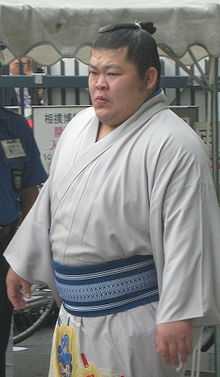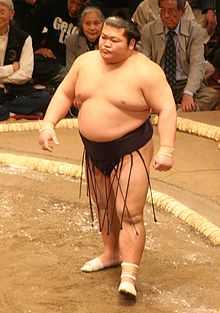Takekaze Akira
| Takekaze Akira | |
|---|---|
| 豪風 旭 | |
 | |
| Personal information | |
| Born |
Akira Narita June 21, 1979 Akita, Japan |
| Height | 1.71 m (5 ft 7 1⁄2 in) |
| Weight | 145 kg (320 lb; 22.8 st) |
| Career | |
| Stable | Oguruma |
| Current rank | see below |
| Record | 524-524-46 |
| Debut | May 2002 |
| Highest rank | Sekiwake (Sep, 2014) |
| Championships | 1 (Jūryō) |
| Special Prizes | Fighting Spirit (2) |
| Gold Stars | 1 (Harumafuji) |
| * Up to date as of Apr 27, 2015. | |
Takekaze Akira (born June 21, 1979 as Akira Narita) is a professional sumo wrestler from Akita Prefecture, Japan. A former amateur sumo champion, he turned professional in 2002, reaching the top makuuchi division the following year. He has been a runner-up in one tournament and earned two special prizes for Fighting Spirit. Takekaze is in first place for the slowest promotion from makuuchi debut to the third highest sekiwake rank in history. Aged 35 years and 2 months, he is in first place for the eldest to make his sekiwake debut post WWII.
Early life and sumo background
Born in Moriyoshi, Kitaakita District, Takekaze practised sumo in college and was a very dominant player, having achieved the student equivalent of yokozuna after winning the Kokutai (Japan Games) and All Japan University Championship sumo tournaments in 2001, his fourth year at Chuo University. He made his professional debut in May 2002, joining former ōzeki Kotokaze's Oguruma stable.
Career
Upon entry he was given makushita tsukedashi status and allowed to enter at the rank of makushita 15 due to his amateur achievements. He reached sekitori level in just two tournaments, and was promoted to the top makuuchi division in March 2003, the first wrestler from his stable to achieve this.
Takekaze had to pull out of his debut tournament in the top division due to injury and fell back to the jūryō division. However upon winning the jūryō championship in September 2003 with a 13-2 record he was promoted back to the top division. He took time to adjust to the stronger opposition in makuuchi and did not achieve a kachi-koshi or winning record above the mid maegashira ranks until May 2007. He has tended to struggle when pitted against the top ranked wrestlers and has not managed to defeat a yokozuna to date. However, in January 2008 he produced his best score in the top division, 12-3, which included a defeat of ōzeki Kotoōshū. He was awarded his first special prize, for Fighting Spirit. Consequently, in the March, 2008 tournament he debuted at the komusubi rank, finally breaking into san'yaku. He was the first wrestler from his stable to make the titled ranks.

Takekaze could manage only three wins in his komusubi debut and was demoted to maegashira 8 for the May 2008 tournament. However, an 8-7 score at maegashira 4 in March 2009, which included a defeat of ōzeki Kotomitsuki, saw him climb to maegashira 2 for the May 2009 tournament. He also reached maegashira 1 in November 2009. In September 2010 he finished runner-up in a tournament for the first time, and was awarded his second Fighting Spirit prize, shared with stablemate Yoshikaze. He has managed to stay in the top division since May 2005, but has rarely posted more than 9 wins in any tournament.
In July 2014 Takekaze earned his first kinboshi or gold star for a defeat of a yokozuna with a win over Harumafuji. His 9-6 score at maegashira 4 was enough to earn him promotion to sekiwake for the first time, as everyone else in the division from sekiwake down to maegashira 3 had a losing score, with the exception of sekiwake Goeido who was promoted to ozeki. Not only did Takekaze become the oldest sekiwake debutant since the end of WWII at the age of 35 years two months, but the 64 tournaments it took to reach the sekiwake rank from his top divsion debut is also a record. He performed creditably in the September 2014 tournament, only just missing out on kachi-koshi with a 7-8 record. He remained in the sanyaku ranks at komusubi for the following tournament in November, but could only score 2-13.
Fighting style
Takekaze is almost entirely reliant on oshi-sumo or pushing techniques, and usually loses if his opponents grab hold of his mawashi or belt. As of May 2009, he had won 120 bouts by oshi-dashi or push out, but just 11 by yori-kiri or force out, which is the most popular overall technique in sumo. He also regularly employs hiki-otoshi, the pull-down,and tsuki-otoshi, the thrust over.[1] At just 172 cm (5 ft 7 1⁄2 in) he is one of the shortest men in the top division.
Family
Takekaze was married in August 2006. He has a son, born at the end of 2007.
Career record
| Year in sumo | January Hatsu basho, Tokyo |
March Haru basho, Osaka |
May Natsu basho, Tokyo |
July Nagoya basho, Nagoya |
September Aki basho, Tokyo |
November Kyūshū basho, Fukuoka |
|---|---|---|---|---|---|---|
| 2002 | x | x | Makushita tsukedashi #15
6–1 |
West Makushita #3
4–3 |
West Jūryō #12
8–7 |
East Jūryō #10
10–5 |
| 2003 | West Jūryō #3
10–5 |
West Maegashira #13
1–3–11 |
East Jūryō #8
Sat out due to injury 0–0–15 |
East Jūryō #8
9–6 |
East Jūryō #5
13–2 Champion |
West Maegashira #11
9–6 |
| 2004 | West Maegashira #6
4–11 |
West Maegashira #11
9–6 |
East Maegashira #8
9–6 |
East Maegashira #5
6–9 |
West Maegashira #7
8–7 |
West Maegashira #6
6–9 |
| 2005 | West Maegashira #8
Sat out due to injury 0–0–15 |
East Jūryō #3
11–4 |
East Maegashira #15
9–6 |
East Maegashira #11
8–7 |
East Maegashira #9
7–8 |
West Maegashira #9
9–6 |
| 2006 | East Maegashira #3
4–11 |
West Maegashira #9
9–6 |
West Maegashira #4
2–13 |
West Maegashira #13
9–6 |
East Maegashira #10
10–5 |
East Maegashira #4
6–9 |
| 2007 | West Maegashira #8
8–7 |
West Maegashira #4
7–8 |
East Maegashira #5
8–7 |
East Maegashira #3
4–11 |
East Maegashira #8
9–6 |
East Maegashira #5
6–9 |
| 2008 | East Maegashira #7
12–3 F |
West Komusubi #1
3–12 |
West Maegashira #8
6–9 |
East Maegashira #12
7–8 |
East Maegashira #14
9–6 |
East Maegashira #8
9–6 |
| 2009 | East Maegashira #3
7–8 |
East Maegashira #4
8–7 |
East Maegashira #2
4–11 |
East Maegashira #9
8–7 |
West Maegashira #5
9–6 |
East Maegashira #1
6–9 |
| 2010 | West Maegashira #4
6–9 |
West Maegashira #8
5–10 |
East Maegashira #12
8–7 |
East Maegashira #11
6–9 |
West Maegashira #12
12–3 F |
West Maegashira #4
6–9 |
| 2011 | East Maegashira #7
8–7 |
West Maegashira #4
Tournament Cancelled 0–0–0 |
West Maegashira #4
7–8 |
West Maegashira #4
8–7 |
East Maegashira #3
5–10 |
West Maegashira #7
10–5 |
| 2012 | East Maegashira #1
4–11 |
West Maegashira #8
9–6 |
West Maegashira #3
7–8 |
West Maegashira #4
7–8 |
West Maegashira #5
8–7 |
West Maegashira #3
4–11 |
| 2013 | West Maegashira #9
6–9 |
East Maegashira #11
9–6 |
West Maegashira #6
9–6 |
East Maegashira #1
1–9–5 |
East Maegashira #11
9–6 |
West Maegashira #3
7–8 |
| 2014 | West Maegashira #4
6–9 |
West Maegashira #6
9–6 |
West Maegashira #1
6–9 |
West Maegashira #4
9–6 ★ |
West Sekiwake #1
7–8 |
East Komusubi #1
2–13 |
| 2015 | West Maegashira #9
9–6 |
East Maegashira #4
4–11 |
East Maegashira #8
– |
x | x | x |
| Record given as win-loss-absent Top Division Champion Retired Lower Divisions Sanshō key: F=Fighting spirit; O=Outstanding performance; T=Technique Also shown: ★=Kinboshi(s); P=Playoff(s) | ||||||
See also
- List of active kinboshi earners
- Glossary of sumo terms
- List of sumo tournament second division champions
- List of active sumo wrestlers
References
- ↑ "Takekaze bouts by kimarite". Sumo Reference. 12 May 2009.
- ↑ "Takekaze Akira Rikishi Information". Sumo Reference. Retrieved 2013-01-27.
External links
- Takekaze Akira's official biography (English) at the Grand Sumo Homepage